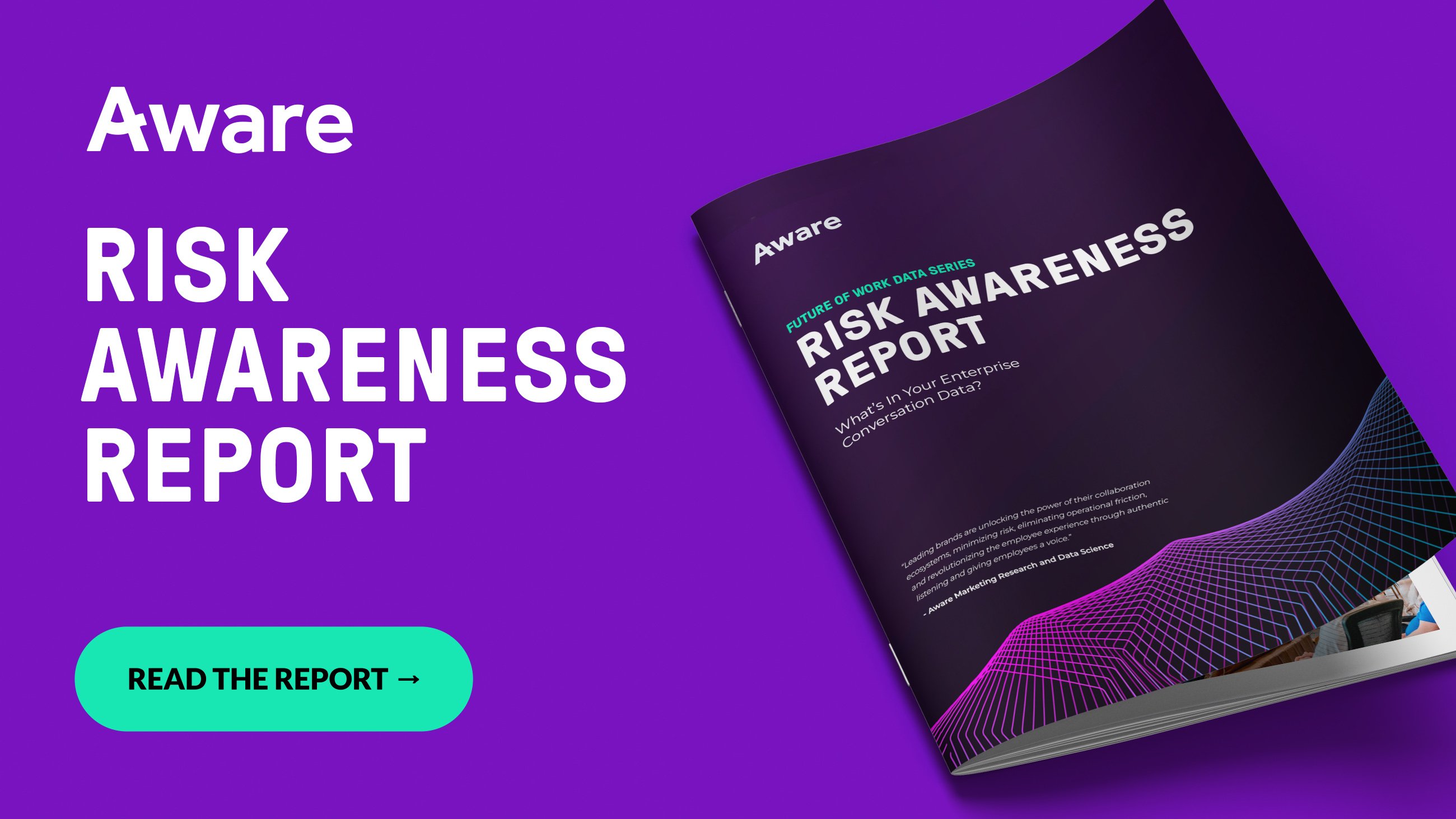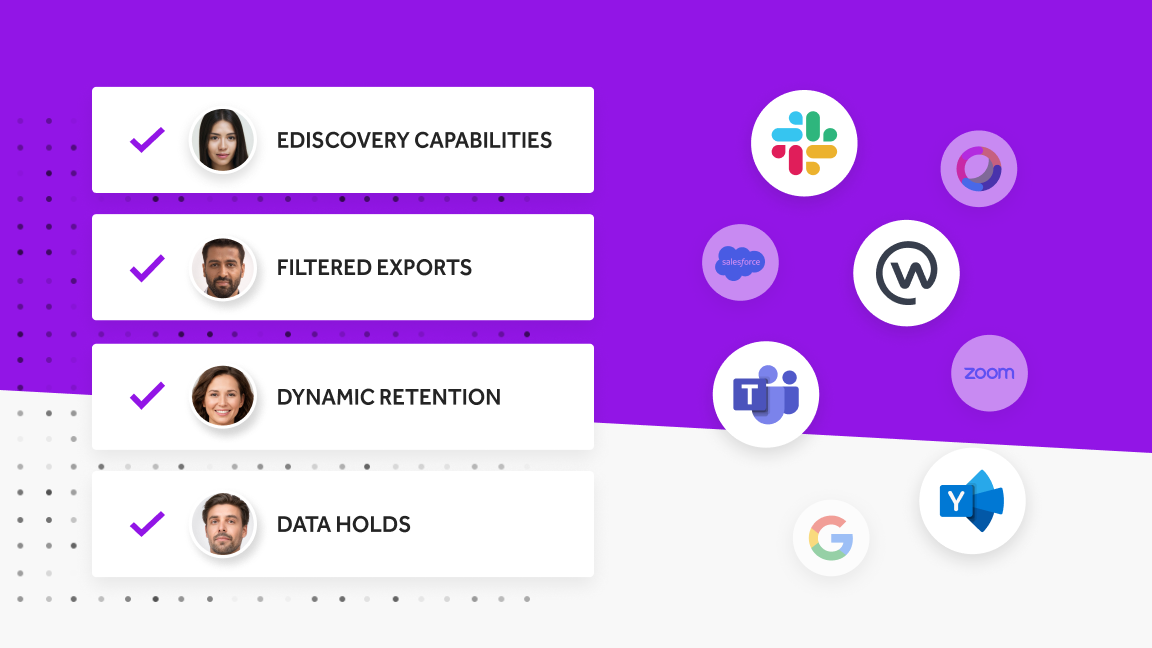A Comprehensive Guide to eDiscovery
by Aware
A massive number of messages are shared between employees across collaboration tools every day, and any of those messages can become significant to a legal investigation. This article explores how eDiscovery solutions help businesses to take control of this data and find the needle in the haystack during internal investigations and early case assessment.
What is eDiscovery?
Electronic discovery, or eDiscovery, refers to the specific process of identifying, collecting, analyzing, and producing electronically stored information (ESI) as electronic evidence for legal cases or regulatory investigations.
eDiscovery tools search and contextualize email, instant messages, social media, and thousands of other types of electronic documents and communications, saving organizations time and money while reducing risk exposure. The basics of eDiscovery ensure transparency, fairness, and compliance with legal and regulatory requirements.
Contents
- Why is eDiscovery important?
- What makes eDiscovery challenging?
- What are the stages of eDiscovery?
- What are the types of eDiscovery software?
- How to modernize your eDiscovery methods
- How to choose the ideal eDiscovery software for your company
- Aware: the eDiscovery solution for the modern digital workspace
Why is eDiscovery important?
With organizations facing increasing collaboration tool sprawl, eDiscovery is a challenge, particularly for data managers, legal professionals, and law firms specializing in eDiscovery.
Successful litigation depends on effective eDiscovery. With the right tools and processes, companies can ensure compliance with court and litigation requirements, streamline the discovery process, and improve their chances of favorable legal outcomes.
eDiscovery also makes data tracking and access easier from a compliance perspective. Centralized data visibility helps compliance teams identify and monitor sensitive data, enforce access controls, mitigate compliance risk, and ensure adherence to regulations.
With the right eDiscovery tools, responding to compliance and litigation requirements is easier, reducing the time and effort necessary to gather and analyze the data for an investigation.
Traditional methods, like manual document review and paper-based discovery, are outdated and time-consuming, and they can be costly. Modern, automated eDiscovery greatly reduces time and expense. Searches can be performed in hours or—with tools that capture source data in real-time—even minutes. Automated eDiscovery platforms help companies better allocate resources while improving the accuracy of the data analysis.

What risks does the modern workplace pose for eDiscovery? We analyzed 6.6B messages to find out
What makes eDiscovery challenging?
According to Aware research, just 100 employees can produce more than 34,000 messages a month across multiple collaboration tools. Much of this data is unstructured and may contain features such as attachments, images, and emojis that add context complexity.
These massive datasets, involving many different file formats, are a primary challenge of eDiscovery. Organizations with hundreds of employees using multiple platforms and databases means gathering, searching, and parsing the data is a mammoth task.
Differing electronic data formats are another difficult challenge. Not only can ESI come from different data sources like email, instant messaging, documents, images, and more, but search output can also be difficult. Slack’s eDiscovery output returns complex and hard-to-read JSON files that require hours to interpret. They also don’t export easily to other eDiscovery workflows, which adds additional time for manual manipulation.
When dealing with sensitive or personally identifiable information (PII), eDiscovery also raises privacy concerns. Legal practitioners must be aware of data privacy regulations like GDPR, CCPA/CPRA, and HIPAA, while collecting, analyzing, reviewing, producing, and presenting ESI during eDiscovery. Robust data protection, data management, and data preservation are necessary to safeguard sensitive information and minimize privacy risks.

Case study: How a major non-profit uses search and discover from Aware
What are the stages of eDiscovery?
Each stage of the Electronic Discovery Reference Model (EDRM) serves a purpose to help establish the data’s parameters and present it in an informative way while preserving its integrity.
%20-%20Page%201.png?width=1200&length=1200&name=9%20Stages%20(1080%20X%201080)%20-%20Page%201.png)
%20-%20Page%202.png?width=1200&length=1200&name=9%20Stages%20(1080%20X%201080)%20-%20Page%202.png)
%20-%20Page%203.png?width=1200&length=1200&name=9%20Stages%20(1080%20X%201080)%20-%20Page%203.png)
%20-%20Page%204.png?width=1200&length=1200&name=9%20Stages%20(1080%20X%201080)%20-%20Page%204.png)
%20-%20Page%205.png?width=1200&length=1200&name=9%20Stages%20(1080%20X%201080)%20-%20Page%205.png)
%20-%20Page%206.png?width=1200&length=1200&name=9%20Stages%20(1080%20X%201080)%20-%20Page%206.png)
%20-%20Page%207.png?width=1200&length=1200&name=9%20Stages%20(1080%20X%201080)%20-%20Page%207.png)
%20-%20Page%208.png?width=1200&length=1200&name=9%20Stages%20(1080%20X%201080)%20-%20Page%208.png)
%20-%20Page%209.png?width=1200&length=1200&name=9%20Stages%20(1080%20X%201080)%20-%20Page%209.png)
%20-%20Page%2010.png?width=1200&length=1200&name=9%20Stages%20(1080%20X%201080)%20-%20Page%2010.png)
Stage 1 is information governance, which manages ESI throughout its lifecycle. Relevant data is classified and retained, and policies are set for how the data will be handled.
In stage 2, ESI relevant information for the legal investigation is identified.
Stage 3 is preservation. The ESI identified in stage 2 is preserved through legal holds to prevent spoliation.
At Stage 4 collection begins, gathering the ESI from identified sources in a forensically sound manner to maintain chain of custody and data integrity.
Processing is stage 5, during which the data is organized, indexed, filtered, and prepped for review and analysis. Duplicates are removed and metadata is preserved and extracted.
Stage 6 is review. The data is assessed for significance, privileged status, and relevance to the case.
Stage 7 takes reviewed items that require deeper examination and analyzes them to uncover patterns and relationships. These advanced analytics are the heart of the eDiscovery process.
Stage 8 begins the production process, which formats the relevant ESI according to the court’s specifications for discovery requests or compliance regulations.
Stage 9 is the final presentation of the ESI in a concise, organized manner during litigation proceedings or regulatory hearings. The presentation may involve exhibits, demonstrations, or summaries that communicate key findings or evidence produced by the eDiscovery.
Start today with DLP and eDiscovery for Slack
What are the types of eDiscovery software?
There are two types of eDiscovery software available today—on-premises and cloud-based software.
On-premises eDiscovery
Companies using on-prem eDiscovery install and operate this software in-house, which requires the purchase and maintenance of hardware and licenses. IT personnel must oversee and support these eDiscovery tools.
Benefits include:
- Complete control over the data and infrastructure. This is ideal for highly sensitive or regulated industries where data security is paramount.
- Greater flexibility and customization to integrate with existing IT systems and workflows. Companies can tailor the eDiscovery solutions to their exact needs.
Cloud-based eDiscovery
Cloud-based eDiscovery is when the software is hosted and operated by third-party services from a cloud. Organizations access eDiscovery services through a subscription, without having to purchase the software itself. An example would be Microsoft Purview.
Benefits include:
- Scalability up or down for organizations that require flexibility based on demand. This method saves significant resources—time, money, and personnel.
- Accessibility from anywhere for companies for whom remote collaboration and faster response times are vital.
- Cloud-based eDiscovery solutions are cost-effective, with lower upfront investment and predictable subscription-based fee structures which are more affordable for small- and medium-sized businesses.
- The service provider is responsible for the maintenance of the software. The subscriber focuses only on their core business needs.
Case Study: How a global retailer uses Aware for eDiscovery
The choice between on-prem and cloud-based eDiscovery solutions depends on data control, scalability needs, and regulatory requirements. Both methods offer solutions to meet professional needs.
How to modernize your eDiscovery methods
Understanding your data ecosystem will help you determine your eDiscovery requirements.
First, where is your data located, and in what formats? Knowing the collaboration tools and apps your organization utilizes and the available formats of the data makes a world of difference in choosing the best eDiscovery tools. Don’t forget to consider shadow IT applications during tech stack reviews.
Next, what are your existing eDiscovery processes? Thoroughly audit your current protocols to find strengths and weaknesses and identify gaps. Don’t forget to gather feedback from stakeholders to minimize their pain points and optimize functionality.
Encourage interdepartmental collaboration to streamline the eDiscovery data-sharing process. When companies implement real-time communication across legal, IT, compliance, and other relevant departments, information can be accessed when it’s needed without costly delays.
Formulate clear-cut governance policies to manage and properly handle ESI. Define data classification, retention periods, legal hold procedures, and RBAC to ensure compliance and regulatory controls. Review these policies regularly for industry best practices.

Download: A quick checklist for legal ops in collaboration
How to choose the ideal eDiscovery software for your company
Once your needs are understood and processes defined, recognizing which eDiscovery software solutions are your organization’s best fit is much more intuitive. Look for software that offers features to fit your needs in a unified platform that integrates with your existing IT systems and workflows and provides the analytics and presentation reporting your company needs.
Keep in mind the following factors:
- Features
- User-friendliness
- Pricing
- Security
Aware: the eDiscovery solution for the modern digital workspace
The Aware platform was purpose-built for eDiscovery across multiple collaboration tools. Our Natural Language Processing and machine learning models can search multiple channels and many data formats, all from a single, secure dashboard interface.
Searches are customizable by custodian, data channel, keyword, and more, and results are refined by date and timelines, sentiment, message type, and content. Aware’s features include:
- One-click legal holds to easily create an immutable archive for a court of law.
- Real-time data collection for a complete record when you need it. Searches take minutes, not days.
- AI-powered filters that return fewer false positives in a context-specific index.
- User-friendly formats for easier data review processes that can be exported into PDF, RSMF, CSV, and more.
- Seamless integration with existing eDiscovery workflows.
- Enterprise-grade data access controls, including RBAC and audit logs.
With Aware, legal teams at some of the world’s leading companies are achieving a more accurate understanding of complex collaboration datasets than ever before. They have full forensic search capabilities for legal and internal investigations and make well-informed decisions about reviewed content. Elevate your organization’s eDiscovery technology with Aware. Contact us today to learn more.








